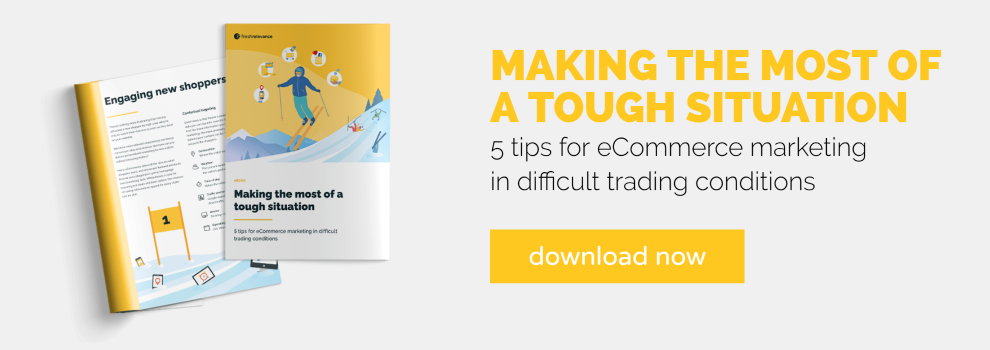Over the pandemic, eCommerce retailers and brands were presented with an opportunity to convert a larger pool of people into customers and foster loyalty as consumers headed online to do their shopping.
However, with the cost of living crisis and the threat of a recession looming large, eCommerce businesses can’t be complacent and the actions retailers and brands take now will have huge implications for their future.
There is a possibility that businesses will have to work with tighter budgets and smaller teams. And whilst annual retail eCommerce sales passed $4.9 trillion worldwide in 2021 (an increase of 16% from the previous year), it’s hard to predict how much consumers will be willing to spend going forward amidst the economic uncertainty.
However, there are ways in which you can protect your eCommerce business during a recession.
Keep reading to discover 7 key ways to survive and thrive throughout a tougher economic climate, including how to:
- Increase customer lifetime value (CLV) and boost customer retention
- Increase return on advertising spend (ROAS) and make your acquisition budget work harder
- Increase customer advocacy and acquire new customers organically
- Understand changes in customer behavior and display relevant content with behavioral targeting
- Be agile in the face of rapid change
- Outsource to stay lean
- Consolidate under-used platforms
1) Increase customer lifetime value
Customer lifetime value (CLV) is the total worth of a customer to your business over the whole period of your relationship. Increasing your CLV is always a good idea, especially during economic downturns, since retaining existing customers is cheaper than acquiring new ones (it can cost 5 times more to attract a new customer than it does to retain an existing one).
Delighting your customers with a smooth, convenient and tailored customer experience is a key way to improve your retention rate and CLV. And in fact, research from McKinsey shows that retailers that master the customer experience fare better in times of social and economic uncertainty. They are far less susceptible to revenue loss during tough times, and they experience three times the returns of their competitors when the economy rebounds.
There are plenty of personalization tactics to help you create a retention-boosting customer experience. Here are two examples.
Triggered emails
Our research shows that 1 in 4 consumers stay loyal to brands that offer great customer service, for example brands who respond to and resolve issues quickly, and almost 1 in 5 consumers stay loyal to brands that understand their needs. Triggered emails are an effective way to send your shoppers timely, relevant information that anticipates their needs.
Emails that are triggered post-purchase are a great way to maintain a strong relationship with shoppers by sending them relevant content once they’ve completed a purchase.
Learn more: 7 ways to keep customers engaged with post-purchase emails
Personalized product recommendations
Almost 1 in 4 consumers want retailers to make it easy for them to discover more products they might like. Marketers can use a customer’s past purchase and browse data to display products that are most likely to pique their interest and encourage them to make further purchases.
Learn more: 3 ways to boost customer retention with product recommendations
2) Increase return on advertising spend
Perhaps your business sells products that are once in a long time/lifetime purchases, such as beds or vacations. If that’s the case, decreasing your cost per acquisition (CPA) will be a more valuable area of focus than increasing your CLV.
During a recession, acquisition budgets need to work much harder. One key way to do this is improving your return on advertising spend (ROAS) by optimizing and targeting the customer experience for paid traffic, such as visitors who come through PPC, social media ads, or Google Shopping.
With Fresh Relevance, you can identify this traffic and personalize the experience to their specific needs, from aligning onsite marketing to the relevant inbound campaign to personalizing based on initial search engine keywords.
Learn more: How to convert paid traffic with personalization
The key is to convert paid traffic into email subscribers ASAP so that they can be re-engaged without paying for them again with more acquisition budget, such as via PPC.
3) Encourage customer advocacy
Customer advocacy is when existing customers are so happy with your brand that they sing your praises and encourage their own network to purchase from you. They are typically your most loyal customers.
Customer advocacy enables a business to organically acquire new customers, and so is a particularly great thing to strive for during a recession since it can help minimize customer acquisition costs.
Customer advocacy, loyalty and retention all go hand in hand, so you can use the customer experience tips above to help create those next-level loyal customers who are willing to spread the word of your brand.
What’s more, our research found that more than 1 in 4 consumers stay loyal to retailers that reward them for their loyalty, so it’s important to consider targeting those customers with exclusive content and offers to reinforce their relationship with your brand and show your appreciation.
User-generated content
Once you have customers who are willing to advocate for your brand, one way to utilize this is with user-generated content (UGC). UGC is marketing at its most authentic and can help build a sense of community among existing customers, while making for a cost effective customer acquisition tactic too (1 in 3 shoppers prefer to see a product as it is worn or used by real people as opposed to professional product images).
Try adding live social feeds to your web pages and in emails to showcase your community and give shoppers an idea of how your products can fit into their lives. Make sure you tell customers the type of content you’re looking for and let them know exactly how they should share their UGC, right down to the relevant hashtags.
4) Understand changes in consumer behavior
In the midst of economic uncertainty, it’s no surprise that consumer habits will change. Many consumers will be more likely to seek out bargains and switch to cheaper products, for example.
It’s important to understand the changes in your shoppers’ behavior and take this into account in the content you display and the communications you send out. Behavioral targeting is a great way to do this, as it allows you to take control of your data and segment customers according to their behavior. For example, historic purchase and browse data can be used to identify the customer base who are more drawn towards lower priced items. You can then target this segment of shoppers with sale items or products that have dropped in price.
Learn more: 9 types of behavioral segmentation you should be using to drive conversions
5) Be agile
Agility is key in a rapidly changing environment. This potential recession is unlike previous ones, with factors such as record low unemployment in the UK, the Covid-19 pandemic, cost of living crisis, and rising cost of fuel. This means there is a need for businesses to be able to pivot strategies and change online content across multiple areas and channels quickly and easily.
Tools such as Fresh Relevance’s Experience Management can help with this.
With Experience Management, you can manage and tailor your content across multiple channels all in one place, empowering you to provide a frictionless and relevant experience for your customers, while solving the issue of disjointed teams, channels, tech and data.
“With Fresh Relevance, it’s just a case of one person updating the dynamic slots once a month and then all the content is automatically updated throughout our emails and website.” – Janis Thomas, eCommerce & Marketing Director, Look Fabulous Forever. (Read full case study)
Automatic optimization is another way to adapt to rapid changes. When the market changes quickly, classic A/B testing is too slow; ‘always on’, AI-driven optimization is the way to ensure your marketing continues to convert amidst fluctuating economic conditions and consumer behavior.
Learn more: 11 ways to get maximum ROI from your content with automatic optimization
6) Outsource to stay lean
As we’ve seen here, delivering the best possible customer experience is vital during a recession. But with smaller teams and tighter budgets, perhaps you’re wondering how to make that happen? The answer is outsourcing, as it enables you to grow while building flexibility into your business, which is essential during turbulent economic times.
Implementing a personalization platform such as Fresh Relevance can help you create the conversion-boosting customer experience you envision without having to hire more staff. Fresh Relevance comes with services designed to help you get the most out of the platform and do the tasks you don’t have time to do. From onboarding and implementation to continued optimization of campaigns as business goals grow and change, our customer team ensures every business we work with is successful.
Learn more: How Fresh Relevance helps our customers succeed
“We’ve seen 10X ROI with Fresh Relevance and it’s helped us lower our cost of acquisition. It allows us to act and function like a bigger business without having to take on the extra infrastructure.” – Zach Simbrow, CEO, Van Der Hout Jewelry. (Read full case study)
7) Consolidate under-used platforms
Do an audit of your tech stack and think about the tools you don’t use very often, such as dedicated testing platforms. See if this functionality is integrated into any of the other platforms you use or are considering using. For example, Fresh Relevance is a personalization platform which comes with testing and optimization functionality. You might be able to make significant savings by ditching expensive platforms that you don’t use very often and instead choosing another platform that comes with that functionality included.
Final thoughts
With a recession on the horizon and a very real cost of living crisis, eCommerce businesses need to take action now to survive and thrive. Despite the possibility of working with smaller teams and tighter budgets, there are ways in which retailers and brands can protect their businesses during this tougher climate.
Increase customer lifetime value and boost customer loyalty by creating a smooth, convenient and tailored customer experience through personalization tactics such as triggered emails and product recommendations, and increase return on advertising spend by personalizing the experience for your paid traffic. Encourage customer advocacy to lower your customer acquisition costs and gain new customers organically. Make sure you have behavioral targeting and segmentation in place so you can understand and react to changes in consumer behavior, such as an increase in bargain hunting. Remain agile in the face of a rapidly changing market with tools such as Fresh Relevance’s Experience Management and Automatic Optimization. Outsource tasks to help you improve your customer experience while building flexibility into your business. And finally, audit your tech stack and see if you can consolildate the functionality of under-used tools into other platforms.
Discover 5 tips for eCommerce marketing in difficult trading conditions in our eBook: Making the most of a tough situation.







